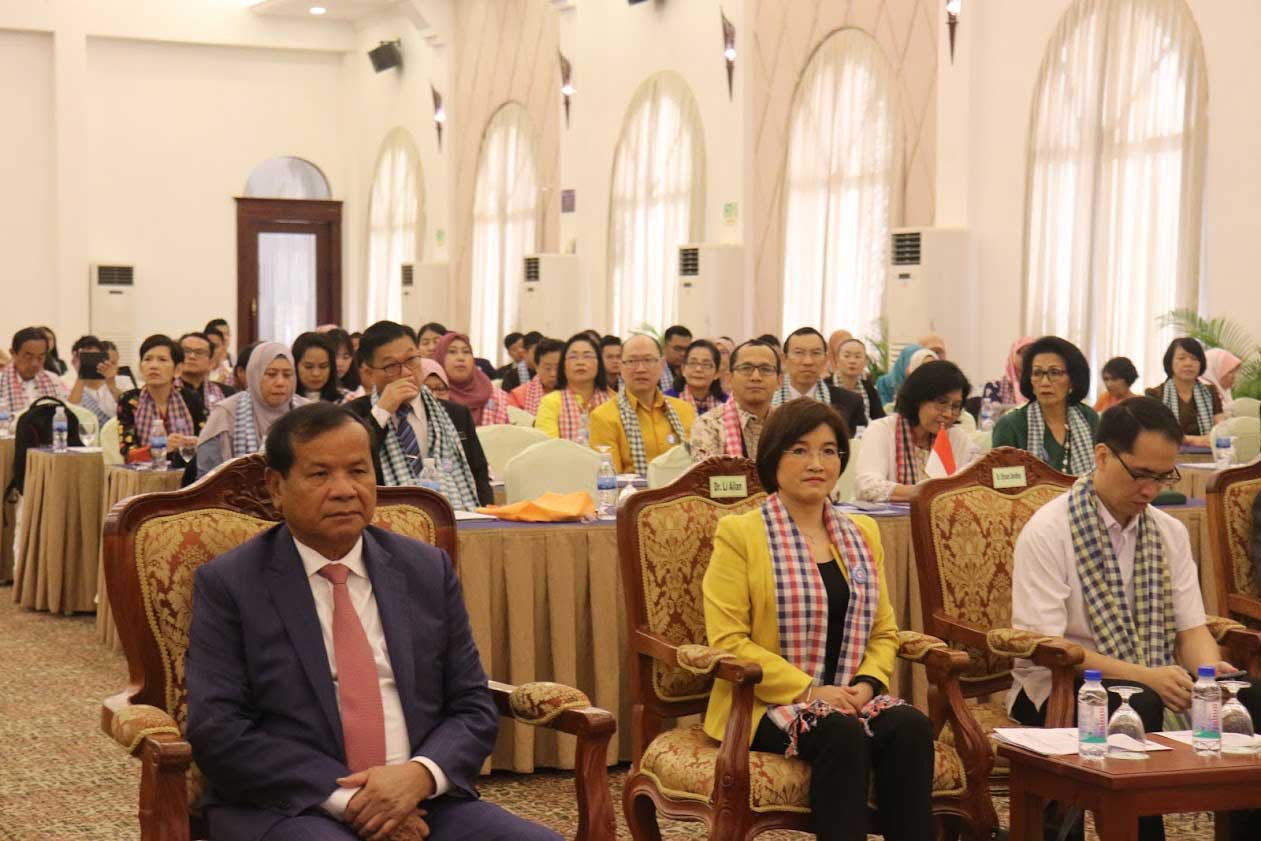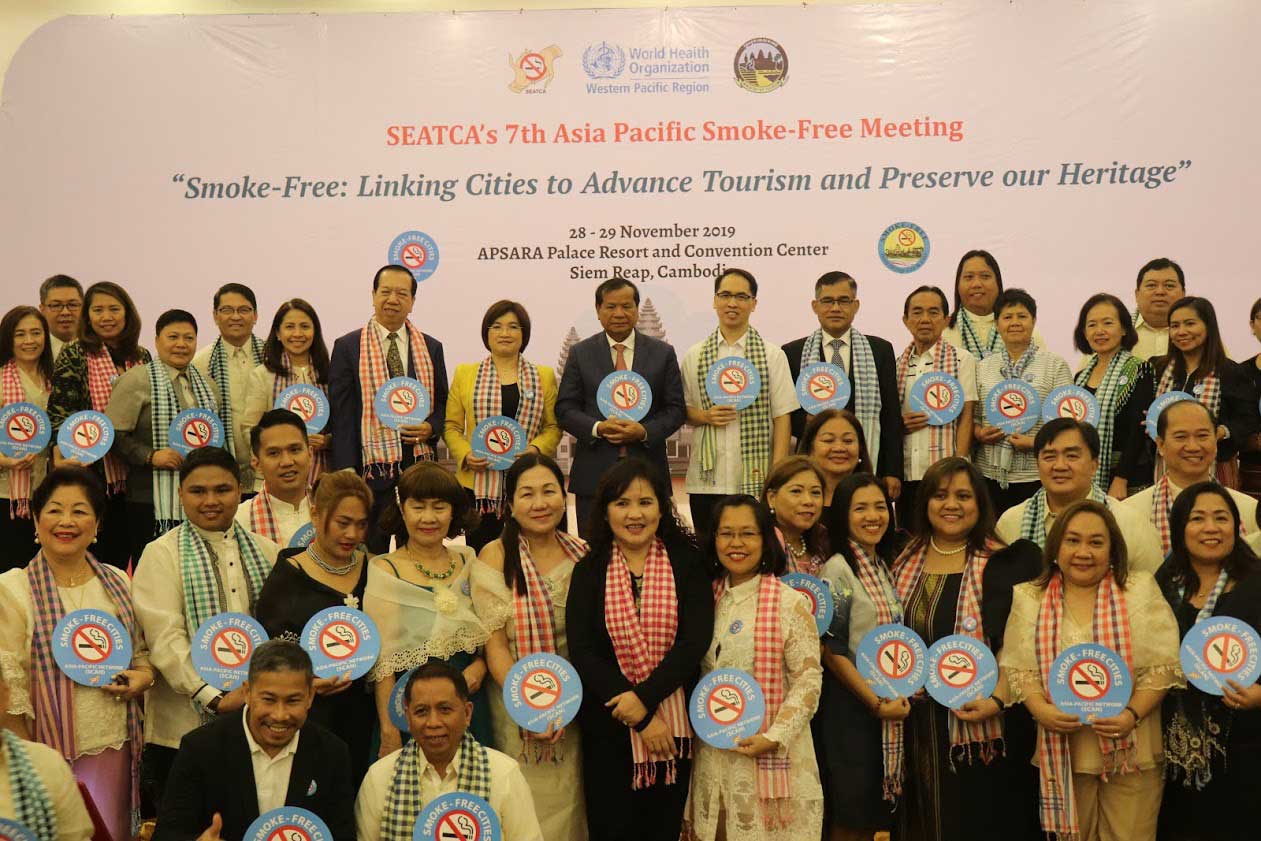“Enforcing a 100% compliance of the smoke-free policy in both work and public places is a much-needed priority. The World Health Organization (WHO) stands ready to continue supporting these efforts.” This was the message of Dr Li Ailan, WHO Representative in Cambodia, during the opening of the 7th Asia-Pacific Smoke-Free Meeting on 28 November 2019 in Siem Reap, Cambodia.

With the theme, "Smoke-Free: Linking Cities to Advance Tourism and Preserve our Heritage,” the two-day meeting gathered around 200 tobacco control advocates, including mayors, smoke-free coordinators, and representatives from the Ministries of Tourism and Health, from 14 countries including the 10 ASEAN (Association of Southeast Asian Nations) countries, China, Japan, Mongolia, and Palau. The meeting provided opportunities to share experiences, learn about good practices, and collaborate to achieve smoke-free environments. This annual meeting has been organized since 2013 in collaboration with the Southeast Asia Tobacco Control Alliance (SEATCA) to promote the implementation of the WHO Framework Convention on Tobacco Control (FCTC) Article 8 "Protection from Exposure to Tobacco Smoke" and its guidelines for implementation at subnational jurisdictions and sites. This year’s meeting focused on promoting smoke-free environments in tourist destinations and heritage sites.
At the end of the meeting, the delegates adopted the Siem Reap Declaration for Smoke-Free Tourism and Heritage Sites, affirming their commitment to promote smoke-free tourism and ensure that 100% smoke-free environments are an essential component of healthy and sustainable tourism of their respective jurisdictions.
Whole-of-government and whole-of-society approach
The implementation of smoke-free laws requires engagement of stakeholders across the health sector, non-health sectors, and civil society. Siem Reap, the host city of the meeting, offers rich experience in multisectoral actions on tobacco control.
H.E. Dr Ung Phyrun, Secretary of State of the Ministry of Health, reiterated the importance of working beyond the health sector in advancing tobacco control in Cambodia. “Since becoming a party to the WHO FCTC in 2005, the Ministry of Health Cambodia, the National Tobacco Control Committee, with the National Center for Health Promotion as the focal point on tobacco control, have worked with partners to make significant achievements in fighting the tobacco epidemic,” he said during the opening of the meeting. H.E. Dr Phyrun also expressed his gratitude to relevant institutions, particularly the local governments, in promoting the effective implementation of the Tobacco Control Law, and further called for a united commitment and action in the country and the Asia-Pacific region to fight the tobacco epidemic together.
Prior to the adoption of Cambodia's Law on Tobacco Control in 2015, a circular banning smoking at workplaces and within the compound of Angkor temple sites was issued in 2012 by the Authority for the Protection and Management of Angkor and the Region of Siem Reap (APSARA). The circular aims to protect the people of, and visitors to, the country's main tourist attraction from the harms of exposure to second-hand smoke, as well as to preserve the World Heritage Site of Angkor, recognizing that heritage sites are also at risk of damage from tobacco smoke.

In collaboration with the Ministry of Tourism and other non-government organizations, the APSARA Authority created a technical working group to oversee the implementation of the smoke-free circular. Various activities were held in support of the dissemination of the circular, such as installation of smoke-free Angkor sites billboards, posting of "No Smoking" signs in workplaces, public places and within the compound of Angkor temples, training of tour guides on increasing awareness and enforcement of the circular, and anti-tobacco mass media campaigns.
As part of its commitment, the Ministry of Tourism co-organized the 7th Asia-Pacific Smoke-Free Meeting with the Southeast Asia Tobacco Control Alliance (SEATCA) and the WHO Regional Office for the Western Pacific. Cambodia's Ministry of Tourism proactive engagement in implementing tobacco control measures sets an example for the region.
Political will and leadership at the subnational level
Several local chief executives participated in the meeting and presented their own smoke-free programmes. Subnational leaders who are supportive of smoke-free initiatives are vital in the success of these campaigns. It is also worth noting that leaders who are exerting significant efforts to make their respective jurisdictions 100% smoke-free can also influence others' thoughts and actions.
This meeting was an excellent opportunity for local leaders and smoke-free coordinators from across the Asia-Pacific region to share experiences and learn from lessons identified in each city/jurisdiction in their implementation of smoke-free laws. Subnational governments have increasingly become aware of the importance of adopting comprehensive smoke-free laws to protect both public health and tourism from the harms of tobacco smoke. In the absence of national laws, subnational units have become important intervention points for stronger tobacco control measures.
In Cambodia, the Ministry of Health established the Smoke-Free City Alliance to strengthen the role of subnational governments in enforcing the Tobacco Control Law through awareness-raising activities and mobilization of support for enforcement.
Opportunity to work together
There is much work to be done but there is a clear opportunity to work together towards achieving the ultimate goal of 100% smoke-free environments. SEATCA organizes this annual regional smoke-free meeting of the Smoke-Free Cities Asia Pacific Network (SCAN), a coalition of provinces, states, cities, municipalities, and districts working towards a 100% smoke-free environment. SCAN provides a platform for members to work together and contribute to the national efforts of saving lives. The meeting is also an opportunity to build networks and alliances with fellow members from across the Asia-Pacific region and update each other on their smoke-free initiatives. The next meeting will be held in Baguio City, Philippines, as the country was elected as the new SCAN Regional President. To date, the Network has 174 members, including Siem Reap City, Siem Reap Province, and Phnom Penh Capital City, that are committed to protecting people from the harms of exposure to tobacco smoke.

In continuing its efforts to achieve 100% smoke-free environments and avert tobacco-related deaths, Cambodia aims to expand the number of smoke-free tourist destinations in the country, starting in Siem Reap. His Excellency Dr Thong Khon, Minister of Tourism, urged the ministries and institutions and stakeholders to make Pub Street in Siem Reap a smoke-free zone. "The Royal Government of Cambodia views tourism as a “green gold” in contributing to socioeconomic development as well as protecting the environment and preserving traditional culture, temples and priceless heritage. Smoke-free environment in tourism is a principle that the Ministry of Tourism had adhered to in promoting the prevention of diseases and the environment arising from tobacco products. The Royal Government of Cambodia has set up a smoke-free environment working group in tourism to work directly with relevant sectors in the tourism sector," he said.
With collaborative mechanisms like SCAN, it is hoped that more will be added to the list of smoke-free jurisdictions and heritage sites, not just in Cambodia but across the Asia-Pacific region as well. Protecting people's health and tourist sites by enacting smoke-free laws is a win-win for all.



